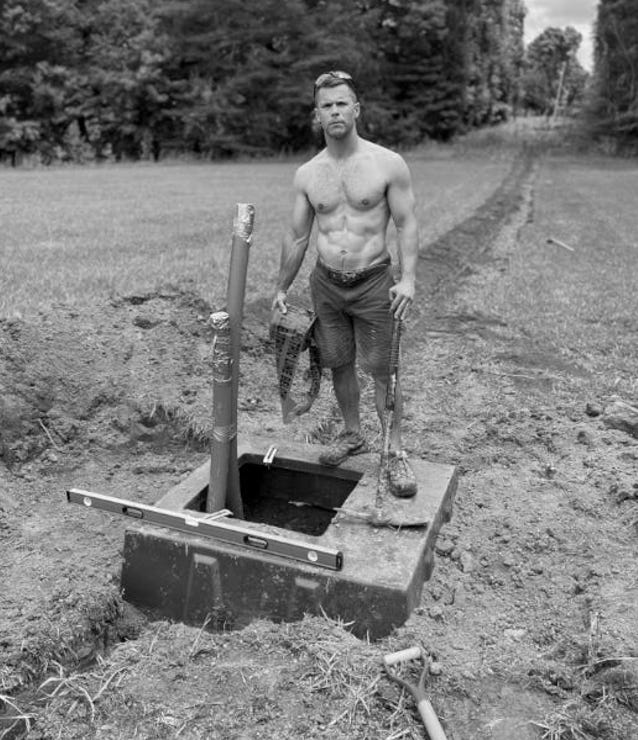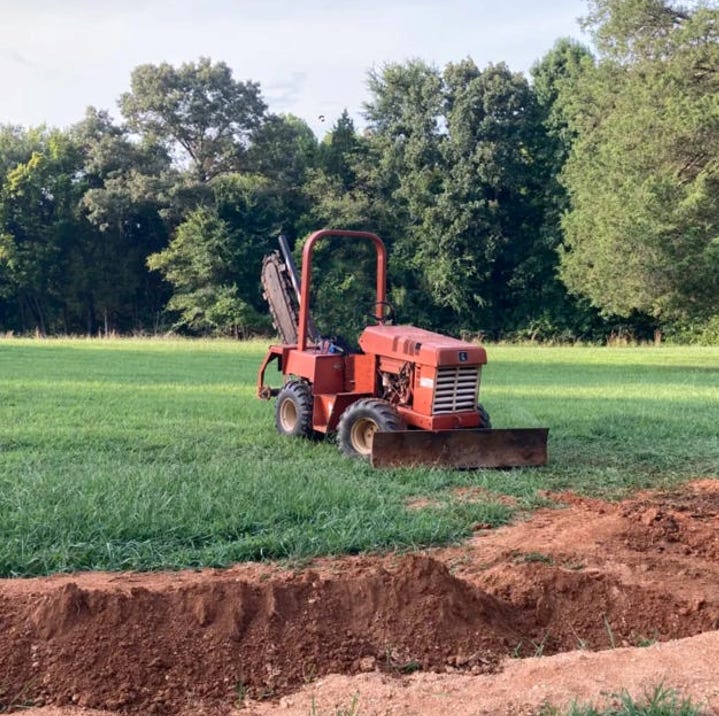The Symbol Manipulators and the World Sustainers, part two
When your head is in the clouds, your feet are not on the ground.
Note: This is part two of this essay . You can read part one here.
A Symbol Manipulator Tries World Sustaining
When we bought our land, it departed from the ideal in only one particular: 800 feet of aboveground powerlines traversed the distance from the nearest public road to a utility pole serving us and a single, friendly neighbor.
Late last summer, I committed to burying these lines. Doing so would remove the land’s only defect, permitting any visitor to experience the sublime vistas unmarred by the unsightly evidence of man’s insatiable desire for power.
I coordinated logistics with the local utility. Not unexpectedly, I would be responsible for digging the trench, installing the junction boxes, laying the conduit, and paying for these items. When all that was complete, the utility agreed to provide and pull the new lines, also at my expense. Of course.
Next I phoned Brian, a local plumber and world sustainer whom I had met a few years prior. Brian offered his trencher and a willingness to assist for a reasonable price. His generosity gave a needed boost to morale and power.
I resolved myself to the total financial cost, which was unpleasant (thanks to the utility), and my own hard labor, which wasn’t.
The process began by marking and then digging a trench four inches wide, three feet deep, and 800 feet long. The trencher is a perfect tool for this project. It is nothing more than a combustion engine, some hydraulics, and an auger on a boom. Its primary purpose is to convert chemical energy (gasoline) into elliptical movement (the augur). By adding teeth to the augur, the elliptical movement is transformed into an infinite series of mini shovels each roughly three inches wide.
The trencher applied these mini shovels to the ground with awesome force and incredible persistence-cutting three feet down into the hard Earth with ease. It then deposited the resulting soil in uniform mounds adjacent to the trench, and proceeded forward at a (very) slow crawl. Though an infant could walk the length of the trench more quickly than Brian cut it, it would take 500 men to dig it in less time than required by the trencher.
Or, I should say, normally the trencher would complete this task relatively quickly. But, in a visceral reminder of Murphy’s Law, a hydraulic line burst when the trench was 75% complete, spewing hydraulic fluid onto the ground. Fortunately, Brian told me he knew a guy.
When a world sustainer like Brian says “don’t worry, I know a guy,” he means far more than he says. The lack of precision in the words does not belie a lack of precision in the idea. Indeed, those succinct five words are a proxy for a robust idea-one that a symbol manipulator like me could spend hours describing. I won’t do that. Suffice it to say, when Brian said “don’t worry, I know a guy,” he meant all of the following and more: (1) I know a guy who knows how to repair hydraulic lines; (2) he’s not a pretender; (3) he’s available; (4) he’s reliable; (5) he’s honest; (6) he’s efficient; (7) his prices are fair; (8) he will answer my phone call; and (9) he will come if I ask. I could go on.
In other words, one world sustainer (Brian) was telling a symbol manipulator (me) about another world sustainer who could solve my problem-I just had to ask. It’s sort of like the Bat signal. But real.
I’m sorry to report that I did not get to meet this second world sustainer. This unfortunate outcome was largely a consequence of two facts: first, he was very busy sustaining the world and, second, he was very good at it. Put another way, I didn’t meet him because he came very quickly, fixed the hydraulic line very quickly, and departed very quickly. I wasn’t home at the time. He charged nothing, or at least Brian wouldn’t tell me what he charged and wouldn’t let me pay for it. I was moved by this generosity, but could not accept it and compensated Brian for the extra cost when the project was finished.
At any rate, with the machine fixed, Brian completed the remainder of the trench with ease.
A trencher is an essential tool for this process, but it is almost never sufficient. Though I’m a lawyer, I’ve dug many thousands of feet of trenches-usually for drainage. Blood, sweat, and deltoids sore from hard labor are an inescapable part of it. And labor I did, spending several days slightly expanding the width of most of the 800 feet of trench with a trenching shovel.
This was necessary to accommodate the electrical conduit, which, at 2.5 inches in diameter (on the interior) can be placed easily only if the hole is four inches wide. The trencher, however, dug a hole only about three inches wide. The extra inch would provide the wiggle room needed to accommodate the imprecision of all things real: human-made “straight” lines, soil that dries and crumbles, stiff HDPE, inconveniently-buried granite, etc.
Unfortunately, widening the trench by scraping also made it shallower, as loose dirt from the trench walls fell to the bottom along all 800 feet. This had to be removed to satisfy the code requirements that electrical lines be buried at least three feet. To remove it, I stood astride the trench, bent over, and swung a narrow pick-axe in sweeping inverted parabolas, flinging the dirt out as I walked, while slowly perfecting my arcs to avoid the walls. Hundreds (thousands?) of man-pendulum arcs later, the trench was clear. Our chickens watched my slow progress with indifference.
After four days of hard labor, I was ready for the initial utility inspection. This required two weeks to arrange and minutes to complete. The inspector walked the length of my trench to confirm its depth: three feet. He didn’t bring a tape measure. With enough experience, I suppose one knows what is and is not a three-foot trench. We passed. It’s worth pausing to observe that this was an encounter, albeit brief, with a third world sustainer (Brian being the first, hydraulic Batman being the second): he did not require symbols to tell him the depth of the trench. I suppose that instantaneous and sound judgments about distance, depth, and strength are just a few of the universal skills of all world sustainers.
Next, I arranged to lay 800 feet of 2.5 inch diameter HDPE conduit. HDPE is waterproof and was selected to house the underground electrical lines that, after the conduit was laid in the trench, would be pulled through it. Unlike 20-foot sticks of PVC, which are four times as expensive, unwieldy, and must be bonded together, HDPE is relatively cheap, sufficiently flexible, and requires no PVC cement. Assuming it holds up against time and nature, HDPE is superior to PVC.
With minimal effort, I identified a vendor willing to sell and deliver HDPE at $4 a foot. He arrived in and old Dodge Ram trailing a spool wrapped in thousands of feet of bright red conduit. His 7-year old son rode shotgun. [Note: Though this man was intelligent, he was also crafty to the point of guile, and, I later learned, a deceitful opportunist. Had he lived in a different place, he would mesh well with the symbol manipulators.]
Halfway along its 800 feet, my trench is interrupted by a junction box that I installed. This junction is necessary because the utility can’t easily pull electrical lines farther than 400 feet through conduit. Thus, the vendor cut the conduit into two pieces of 400 feet each and laid them on the grounds parallel to the corresponding trenched sections.
I then walked the entire length of the trench pushing the HDPE in as I moved. The ease with which the HDPE fell unimpeded to the bottom was a welcome tribute to my sore deltoids and perfected parabolic arcs.
The next day, Brian and I alternated operating the small tractor, of which the trencher was a part, to backfill dirt on top of the now subterranean HDPE conduit. Other than the minor inconvenience of the junction box, laying the conduit was the easiest part of the whole affair.

Having completed the trench, I was ready to schedule the utility inspection. Following that, I would coordinate with the utility to remove the above-ground poles and lines and to pull the new underground electrical through my freshly-installed HDPE conduit. But all of that was yet to come.
In the meantime, I was pleased with my work and proud of my accomplishments. And though I knew that this same feat had been accomplished millions of times across this grand country by the men I call the world sustainers, still I was unprepared to meet them in force - that breed of men who build and sustain the infrastructure of the world.
But meet them I did. And not a minute too late, now that their time has come again.
A request from the author: If you enjoyed this essay, please “like it,” share it, and comment. And please don’t hesitate to reach out directly. Your feedback is the fuel I use to continue writing.






"I know a guy" who does favors for free is common in the South. You offer to pay, they say, "No problem." You ask, "Are you sure?" They say, "No, I'm good." You say, "Thanks, man," and let it go.
This is how you build your roll-a-deck of "I know a guy" referrals. Eventually, you send paying referrals to them, or they contact you for your services. Even better, you make friends.